Project Year
2010
Region(s)
Southeast Asia
Country(ies)
Philippines
Project Description
This study seeks to examine the financial and economic lives of Philippine indigenous peoples, particularly their gendered utilization of new technologies, such as money as a form of exchange, in ways such as saving, storing, and spending, giving special analytical attention on indigenous women’s economic (in) dependency from men. In addition, this study will investigate the IP’s perceptions about, and experiences with, the burgeoning micro-financial institutions in their communities, with emphasis on the contribution of micro-finance on women’s economic empowerment.
Researcher(s)
Mary Janet Arnado
About the Researcher(s)

Synopsis of Research Results
Modernity, gender and money in traditional societies
This paper explores the relationship between modernity and gender in a traditional society, using as a case the informal storing of money among indigenous populations in the Philippines. It examines 1) gender as the interface between tradition and modernity; 2) money as the interface between tradition and modernity; and 3) money as the interface between men and women. In particular, the paper examines the ways modernity reshapes and reworks gender relations by looking at informal money storage which provides evidence of rationality and individualism that are characteristics of modernity; and also indications of tradition such as the house as a site of storage, and relationships and livestock as forms of money. In addition, this study examines money storage as a social process whereby modernity and tradition are inherently intertwined and gendered. Finally, the paper investigates gender as a class and a site of bargaining observed in the ways men and women store their money, where relations can be harmonious or antagonistic inasmuch as men and women share or conceal money from each other to protect their gendered interests in the family.
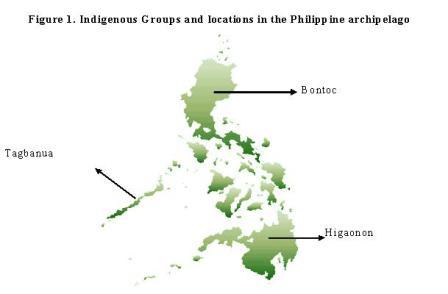 |
A descriptive exploratory research employing qualitative strategies was conducted in three selected indigenous communities in the Philippines. These communities include the Bontoc in Sadangga of the Cordillera region, the Tagbanua in Palawan, and the Higaonon in Bukidnon, representing northern, western and southern regions of the country, respectively (see Figure 1). In-depth interviewing with 69 informants is the primary research technique, supplemented by participant observation by three research associates who have worked or were currently working with these three indigenous groups. Using purposive sampling, 23 informants with the following characteristics were interviewed from each of the three communities: four elderly (2 males, 2 females), two adolescents (1 male and 1 female), three from microfinance organizations, and the remaining 14 informants were household heads and their spouses.
In this study money is defined both in modern and traditional sense, to include cash, cash-convertible assets, and non-monetized relationship of exchange. Cash is in the form of Philippine currency consisting of bills and coins. Cash-convertible assets consist of livestock which are mostly chickens and pigs; cash crops such as rice, corn and vegetables, and forest products such as almaciga resin which is very popular among the Tagbanua. The last category of money, the non-monetized relationship of exchange involves the barter of goods (labor for food; orchids for clothes; rice for salt) and reciprocal social obligations manifested in thanksgiving, wedding, and death.
Storing cash among the Philippine indigenous peoples in this study is not a common practice, as they hardly possess sufficient amount of money to get by. Individuals frequently store small amounts of money for short durations. The concept of “lugi”, a Visayan term synonymous to what is generally referred to as “piggy bank” defines the informal cash storing practices of the indigenous peoples. The lugi is made of a wide array of materials, stored in various durations depending on purpose, and provided with different levels of safety measures based on its value.
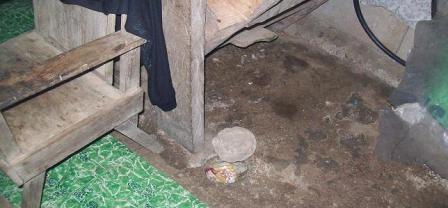 |
|
Figure 2. Money was hidden underneath the plastic wrapper, then covered with lid and the green floor mat. Photo taken by Genevieve Labadan |
The informal storing of monies among the Philippine indigenous peoples is embedded in household gender relations of power, in the same way that gender relations are affected by informal storing. According to Georg Simmel, storing money sustains the potentiality of power associated with the usage of money: “the significance of money coincides with that of power; money, like power is a mere potentiality which stores up a merely subjectively anticipatable future in the form of an objectively existing present” (Simmel 1982, 243). This establishes the potentiality of power by men and women towards each other. Concealment of money from one’s spouse is a strategy to assure oneself of this power, for example, to control the use of material resources for the family.
Gender shapes practices on informal storing of cash, particularly in terms of duration, location, and purpose of storing. Indigenous women tend to store for short-term duration while men for longer term, as the former address the immediate needs of the family, whereas the latter, the intermediate ones. Women tend to store money within the house, which is their realm of authority and their comfort zone. Women’s stored money is more visible than men’s, and hidden in less fixed state as they often open it to pay for daily needs. On the other hand, because men tend to store money for longer duration than women do, they tend to hide it in more permanent locations, inside their house, in a nearby empty lot, or in the rice granary. Aside from time, the value of money is also considered when storing. The more valuable the money, the more difficult it is to find the stash. Higaonon men for example kept monies in their house under dug cemented floors, inside bamboo house columns, or a well-secured chest.
As their house structure can easily be transgressed by unwanted intruders, such as thieves, spouses, and children, men and women weave a cunning strategy of secrecy, deception, and lies to protect the money they store. Women’s strategies diverge from visibility to invisibility. Coins are stored in a “lugi”or a piggy bank in various forms such as a coke bottle or short bamboo pole. Lugi is more or less stored in visible places in the Higaonon house. Shifting to invisibility mode, indigenous women hide more valuable money bills by mixing them up with other household items and keeping them in clusters, to deceive the prospective thief on the exact location of the money and avoid losing money all at once.
| Figure 3. A Higaonon woman storing money in different locations in the house. | |
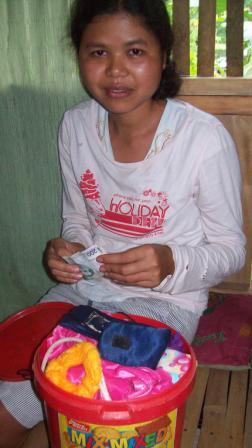 |
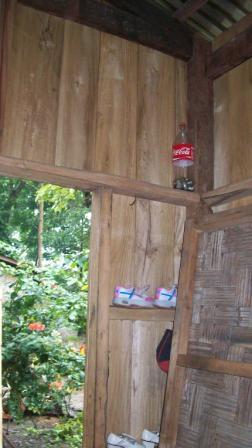 |
| *Photo taken by Genevieve Labadan | |
Conclusions
The paper has examined the relationship between gender and modernity in a traditional society through a case study of informal money storage patterns among the Philippine indigenous population. The study showed that even as indigenous communities are gradually integrated into the mainstream financial system, they continue to maintain an elaborate gendered system of informal storing of money, by hiding cash in various locations inside and outside the house, by raising livestock and planting cash crops, and by fulfilling reciprocal relationship of social obligations through gift giving and spending for celebrations. As such, money is an interface of tradition and modernity in which traditional forms (livestock, relationships, gifts) of money are used side by side the modern form (cash), using one or both types to fulfill the requirements of a purely traditional, purely modern, or both modern and traditional transaction.
| Figure 4. Visibility and invisibility of money |
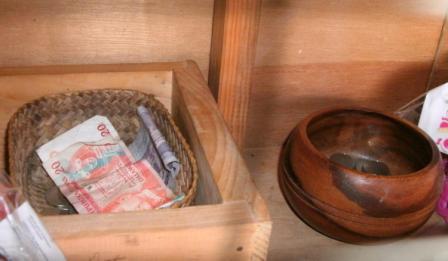 |
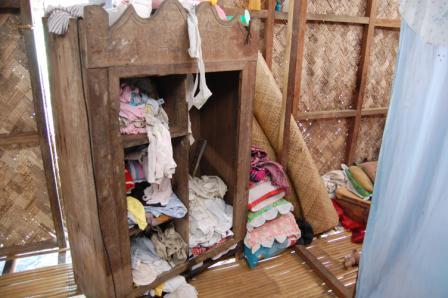 |
| Bills and coins are displayed in the sari-sari store to facilitate monetary transactions. Below: Money is hidden somewhere between clothing and inside the pillows. Photos taken by Jae Estuar (above) and Anthony Aquino (below). |
See Mary Janet Arnado's working paper: Hidden in a Coke Bottle: Modernity, Gender and the Informal Storing of Money in Philippine Indigenous Communities



